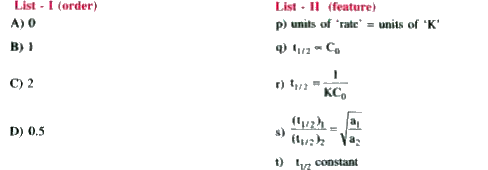In the reaction 2A+B→2C+D, 5 mol/lt of A are allowed to react with 2 mol/lt of B. After 5 seconds the concentration of A was found to be 4 molar. What is the rate of reaction in tems of A?Solution in Telugu
0.1Msec−1
0.2Msec−1
0.3Msec−1
0.15Msec−1
The correct Answer is:A
2A5+B3→2C0+D0
(5−2x)(3−x)2×,x=1/2,rA=5−45=15=0.2 M/sec ,r=12×−d[A]dt=0.22=0.1 M/sec
Topper's Solved these Questions
- CHEMICAL KINETICSBOOK - AAKASH SERIESCHAPTER - CHEMICAL KINETICSEXERCISE - LEVEL-II(LECTURE SHEET EXERCISE-II LINKED COMPREHENSION TYPE QUESTIONS)
9 Videos
- CHEMICAL KINETICSBOOK - AAKASH SERIESCHAPTER - CHEMICAL KINETICSEXERCISE - LEVEL-II(LECTURE SHEET EXERCISE-III MATCH THE FOLLOWING QUESTIONS)
3 Videos
- CHEMICAL KINETICSBOOK - AAKASH SERIESCHAPTER - CHEMICAL KINETICSEXERCISE - LEVEL-1 (EXERCISE -II ORDER, MOLECULARITY, HALF LIFE:)
34 Videos
- CHEMICAL KINETCSBOOK - AAKASH SERIESCHAPTER - CHEMICAL KINETCSEXERCISE - EXERCISE - 3.2
45 Videos
- CHEMICAL THERMODYNAMICSBOOK - AAKASH SERIESCHAPTER - CHEMICAL THERMODYNAMICSEXERCISE - Additional Practice Exercise
54 Videos
Similar Questions
A certain endothermic reaction: A→ Product, ΔH=+ve proceeds ina sequence of three elementary steps with the rate constant K1,K2 and K3 and each one having energy of activation E1,E2 and E3 respectively at 25∘C. The observed rate constannt for the reaction is equal to K3√K1K2.
A1,A2 and A3 are Arrhenius parameters respectively.
The observed energy of activation for the reaction is
View SolutionMatch the following columns

View SolutionSucrose decompose in acid solution into glucose and fructose according to the first order rate law, with t12=3.00 hours. What fraction of sample of sucrose remains after 8 hours ?
View SolutionDiscuss on the kinetic spontaneity of a chemical reaction. Is a slow reaction spontaneous? Why?
View SolutionWhich among the following is not an exact differential?
View SolutionFor the reaction, A+B hArr 2C, 2 mol of A and 3 mol of B are allowed to react. If the equilibrium constant is 4 at 400^(@)C , what will be the moles of C at equilibrium?
View SolutionIn a reaction, n1A+n2B→m1C+m2D,5mollitre−1 of A are followed to react with 3mollitre−1 of B. After 5 second, the concentration of A was found to be B. After 5 second, the concentration of A was found to be 4M. Calculate rate of reaction in terms of A and D.
View SolutionThe rate constant (K) for the reaction, 2A+B→ Product was found to be 2.5×10−5litremol−1sec−1 after 15sec,2.60×10−5litremol−1sec−1 after 30 sec and 2.55×10−5litremol−1sec−1 after 50sec. The order of reaction is:
View SolutionIn a certain reaction 2A+B⇔4C, the concentration of A decreases from 5×10−3 mol/L to 2×10−3 mol/L in 30 s. What is the rate with respect to C ?
View SolutionFor the reaction :
2A+B→A2B , the rate = K[A][B]2 with K=2.0×10−6mol−1lit2sec−1. Initial concentration of A and B are 0.2 mol/lt and 0.4 mol/lit respectively. Calculate the rate of reaction after [A] is reduced to 0.12 mol/lit
View SolutionFor the reaction : 2A+B+CtoA_(2)B+C, the rate law has been determined to be Rate =k[A][B]^(2)" with "k=2.0xx10^(-6)" mol"^(-2)L^(2)s^(1) For this reaction determine the initial rate of the reaction with [A]=0.1" mol L"^(-1),[B]=0.2" mol L"^(-1),[C]=0.8" mol L"^(-1). Determine the rate after 0.04" mol L"^(-1) . Determine the rate after 0.04 "mol L"^(-1) of A has reacted.
View Solution1 mol of N_2 and 4 mol of H_2 are allowed to react in a vessel and after reaction, H_2O is added. Aqueous solution required 1 mol of HCI for neutralization. Mol fraction of H_2 in the mixture after reaction is :
View Solutionअभिक्रिया 2A→B+4C में 10 सेकण्ड में C की सांद्रता 2×10−2molL−1 बढ़ जाती है। C के बनने की दर और A के विलुप्त होने की दर ज्ञात कीजिए ।
View Solution0<A<B<π4, sin(A+B)=2425, cos(A−B)=45 అయితే tan2A విలువలు కనుకోంది.
View SolutionHow many times will the rate of the reaction 2A+B→A2B change is the concentration is expressed in mol/mL ?
View Solution
